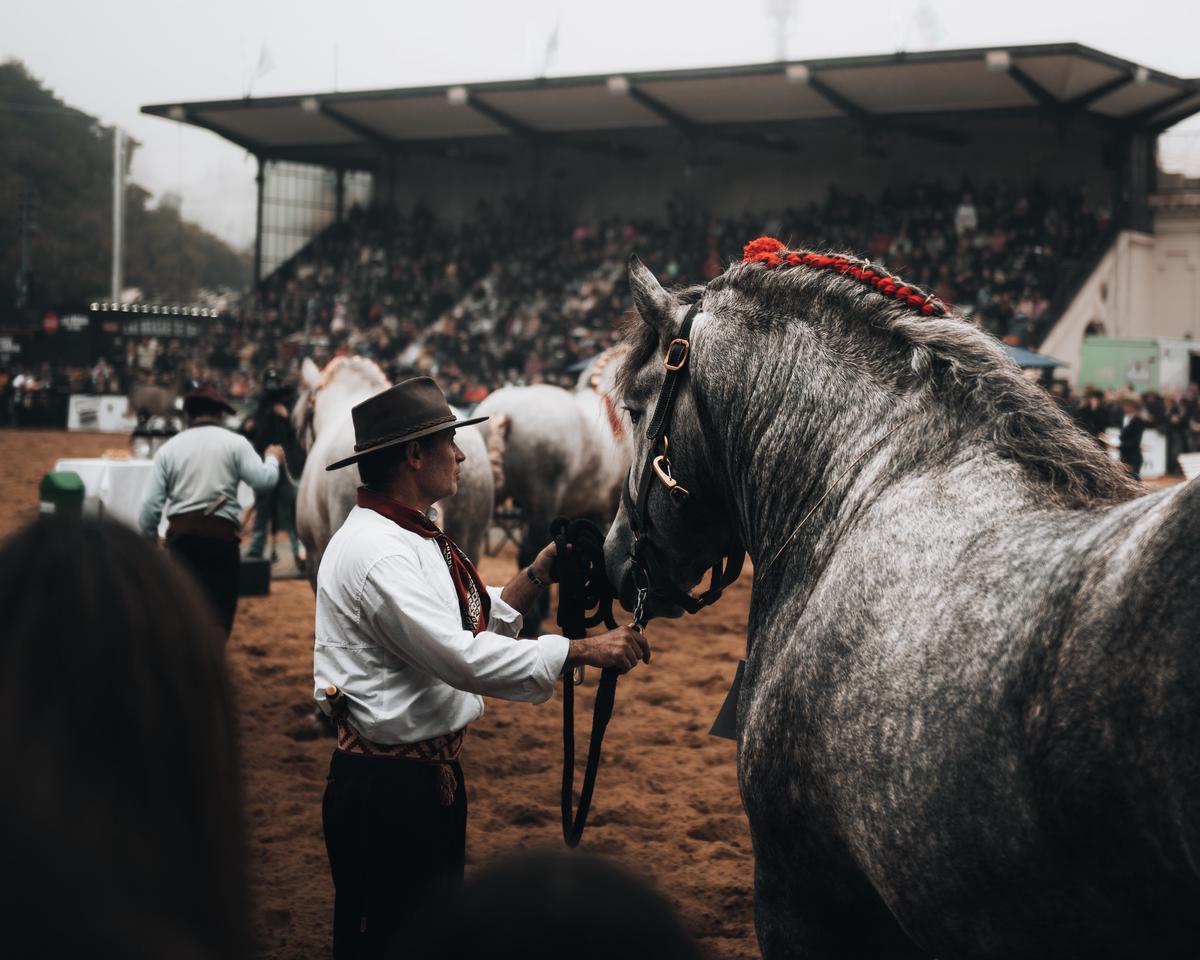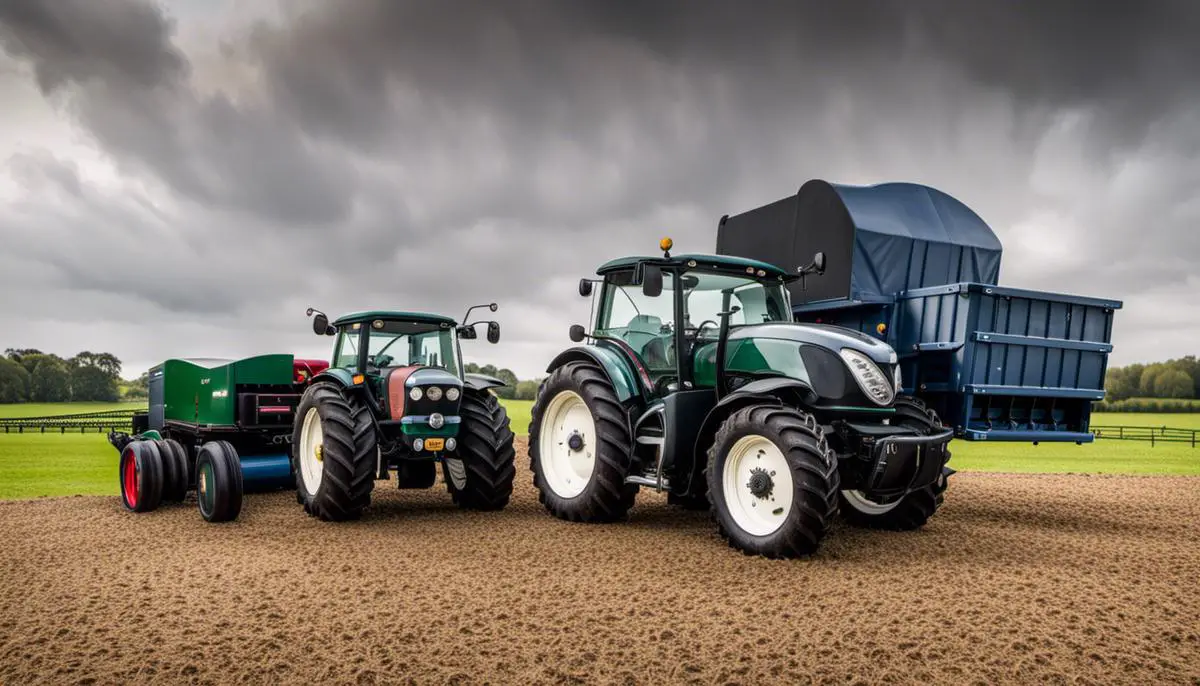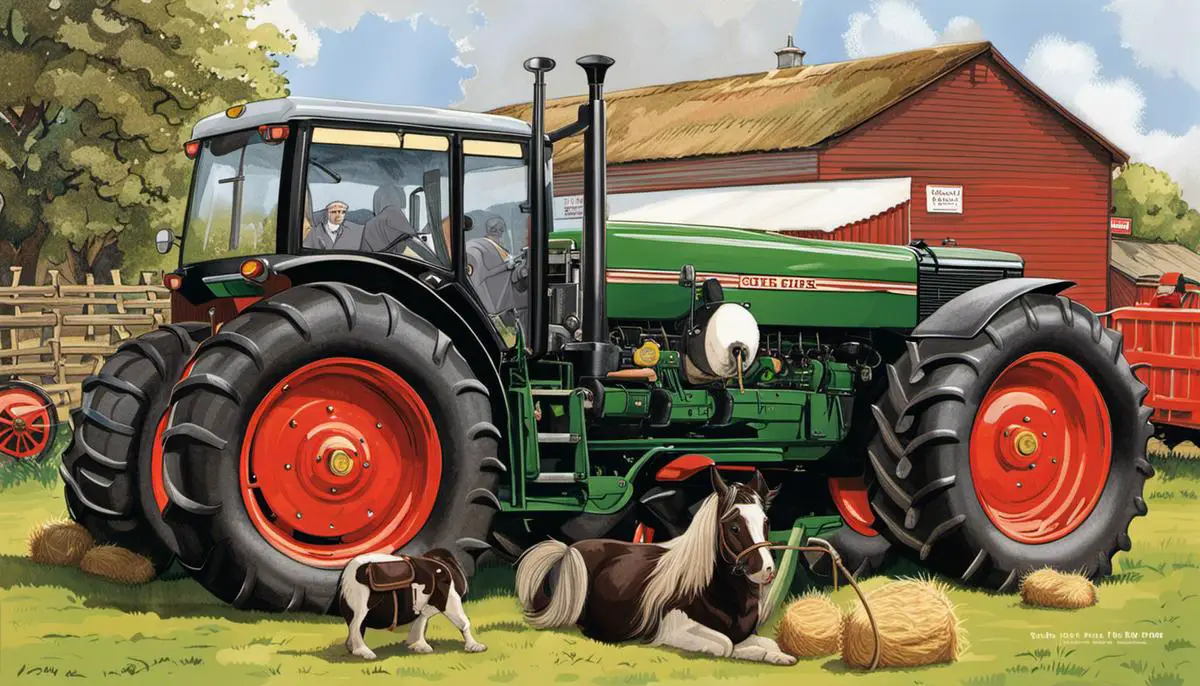Imagine the sight of a robust Shire horse standing next to a heavy-duty tractor. The visual of these two vastly different embodiments of power and strength can be both striking and fascinating. This write-up aims to dive deep into these dissimilarities and similarities, offering comprehensive insight into the world of the Shire horse and its size comparison with a typical tractor. By weaving the rich history and distinctive traits of the Shire horse with an introduction to tractors and their specifications, we provide you with an intriguing exploration of size comparison and functional implications. Prepare to embark on a journey from the quaint countryside stables to the mechanized agricultural fields, discovering along the way, the majestic Shire horse and the formidable tractor in a new light.
Table of Contents (Horspedia)
Understanding the Shire Horse
Understanding the Shire Horse: Magnitude, Might, and Musculature
The Shire horse, known for its stature, strength, and amiable temperament, originated in England. This breed, descended from the medieval ‘Great Horse’, developed as a draft horse capable of heavy labor, including farming tasks often later taken over by tractors. An adult Shire horse typically stands at a formidable 17 to 19 hands (68 to 76 inches) at the shoulder, making it one of the largest horse breeds in the world.
Detailed examinations reveal even more impressive statistics: A Shire horse can weigh between 1,800 and 2,400 pounds, which is close to the weight of a small tractor. This breed’s sheer size is complemented by a surprisingly gentle and docile nature, leading to its nickname, the “Gentle Giant”.
Analyzing the Physical Scale: Tractor versus Shire Horse
When comparing a Shire horse to a tractor, one must consider the different types of tractors available. A small tractor, such as a compact utility model, can weigh around 1,500 to 2,000 pounds and stand about 4 to 5 feet tall. On the other hand, larger agricultural tractors can weigh 10,000 pounds or more and stand more than 6 feet tall.
Although the larger tractor’s size and weight outstrip those of the Shire horse, it’s worth observing that the horse’s strength and agility can sometimes render it more effective for certain tasks. A Shire horse, with its muscular build and great endurance, can effectively work in terrains and weather conditions that might trouble a tractor, such as wet or sloppy ground.
Comparative Efficiency: Shire Horse and Tractor in Farming Contexts
Despite the increasing predominance of tractors in agricultural settings, it’s noteworthy that a Shire horse can be an effective alternative for certain farming tasks. In some sustainable or small-scale farming contexts, it is possible that a Shire horse’s adaptive capabilities may offer benefits that a tractor cannot.
While it can’t compete with a tractor in terms of speed, a Shire horse can plow furrows, pull heavy loads, and assist in logging operations, thanks to its muscular build and impressive stamina. Moreover, the Shire horse does not contribute to air pollution like a tractor and requires only food and water, not costly fuel, for operation.
The Intricate Factors Dictating the Size of Shire Horses
A Shire horse’s true height and weight can be a variable element, largely influenced by genetics, the quality of its diet, and care regimen. This breed has seen centuries of selective breeding practices applied with meticulous measures, which has substantially contributed to their exceptional size and strength. The foundation for this, however, requires proper nutrition and thorough veterinary care, especially during their formative years, in order to build their size and muscular structure.
In contrast to tractors, whose dimensions are confined to engineering and manufacturing standards, a Shire horse’s size is a testament to its incredible journey through evolution, selective breeding, and attentive upbringing. This notable size not only makes them an effective work resource but also a sight to behold because of their sheer elegance and commanding presence.

Introduction to Tractors
An Overview of Tractors and Their Purpose
The term “tractor” is typically associated with the agricultural and industrial machines utilized for farming and construction purposes. As a crucial mechanical tool, tractors serve a myriad of functions including ploughing, tilling, planting, and pulling other farm implements. The efficiency and productivity of farmers and professional agriculturists heavily rely on tractors as they expedite work tasks that would otherwise be incredibly time-consuming and laborious.
Different Types of Tractors
There are many types of tractors, each designed for specific tasks and environments. Among the most common are row crop tractors, utility tractors, and industrial tractors. Row crop tractors are designed to navigate between rows of crops without damaging plants. Utility tractors, often considered the most versatile type, can perform various tasks such as plowing, digging, and hauling due to their power and size. Industrial tractors are robust and massive, primarily used in the construction industry.
Sizes and Dimensions of Common Tractors
The sizes of tractors can vary considerably. Smaller tractors, like garden tractors, can be as little as 4 feet wide and about 8 feet long. They weigh around 2,000 pounds. On the other hand, large industrial tractors can be as much as 20 feet wide and 30 feet long, weighing tens of thousands of pounds. A typical medium-sized farm tractor is about 10 to 20 feet in length, 6 to 10 feet in width, and weighs between 4000 to 8000 pounds.
Introducing Shire Horses – The Giants of the Horse World
Now let’s transition to Shire horses. Recognized as the tallest of the horse breeds, Shire horses can stand anywhere from 16.2 to 17.2 hands high, with “hands” being an equine measurement where one hand equals four inches. As such, this equates to about 5.4 to 5.7 feet at the shoulder. Some specimens have even reached up to 19 to 20 hands, or around 6.6 feet tall. In terms of weight, Shire horses can weigh between 1,800 to 2,400 pounds, though some particularly large specimens have been known to exceed 3,000 pounds.
Comparing Tractor and Shire Horse Sizes
When comparing the sizes of tractors and Shire horses, it’s clear that tractors are generally larger and heavier. Even a medium-sized tractor is likely to weigh twice as much as a large Shire horse and be several feet longer and wider. However, a small tractor’s weight can be similar to that of a large Shire horse. In terms of height, Shire horses are typically taller than many tractors, which are often designed to be relatively low to the ground for stability.
Imagine a visual metaphor of sheer power and size. In this picture, you might see a towering Shire horse standing beside a medium-sized tractor. Their shoulders are level, their massiveness similarly imposing. The equine’s muscular legs are sturdy like the tractor’s tires, engaging a tangible comparison of these two powerful forces – one a product of nature, the other of human ingenuity.

Size Comparison of Shire Horse to Tractor
Proportions of the Shire Horse
Among the champions of the horse world for sheer size and power is the Shire Horse. This breed characteristically stands between 17 to 19 hands high – that is, 68 to 76 inches from hoof to shoulder. There are some instances, however, where a Shire Horse can grow up to 21 hands (84 inches). To put this in perspective, the average height of a medium-sized tractor is around 76 inches, making the height of some Shire horses equivalent or even surpassing that of a tractor. As for their weight, Shire horses range between 1,800 to over 2,200 pounds, with some extraordinary individuals topping 2,400 pounds – almost equal in weight to small tractors. Contributing to this impressive size are the horse’s long legs and robust muscular structure.
Size and Weight of a Tractor
Tractors, on the other hand, come in a variety of sizes. A common small-sized tractor, such as a compact utility tractor or garden tractor, may measure around 9 to 10 feet in length and around 4 to 5 feet in width, with an average weight of 1,500 to 4,000 pounds. A medium-sized utility tractor’s dimensions can range from 15 to 20 feet in length and 6 to 8 feet in width and weigh anywhere from 4,000 to 8,000 pounds. Large industrial tractors, used for heavy-duty tasks, can measure over 25 feet in length, around 10 feet in width, and can weigh between 10,000 to 25,000 pounds.
Comparison of Size and Weight
When comparing the size and weight of a shire horse to a tractor, it’s evident that the horse, even as the tallest and heaviest among horse breeds, is significantly smaller than even a small-sized tractor. However, despite their size difference, both shire horses and tractors can perform similar tasks in terms of carrying or pulling loads, thanks to their formidable strength and power.
In terms of weight, a shire horse is lighter than most tractors. Even the heaviest shire horse would weigh less than a small-sized tractor. The larger the tractor size, the greater the weight disparity becomes, with large industrial tractors weighing ten times or more than an average shire horse.
Shire Horses and Tractors in Real-World Environments
In diverse sectors such as farming, transportation, and construction, both shire horses and tractors serve critical roles. Prior to the invention and widespread utilization of the tractor, large horse breeds, such as the Shire, were the preferred choice for heavy, labor-intensive work. In today’s world, despite the pervasive use of tractors, Shire horses still have their unique contributions in specific scenarios where their size, significantly smaller compared to larger tractors, provides benefits, like increased maneuverability or reduced damage to ecologically sensitive areas.

Implication of the Size Difference
Comparing the Sizes of Shire Horses and Tractors
If we start comparing sizes, Shire horses are among the world’s largest horse breeds. Adult males stand between 17 and 19 hands high, translating to 68 to 76 inches at the shoulder, and weighing between 1,800 and 2,400 pounds. Tractors, meanwhile, show wide variations in size, dependent on the model and the nature of work. Compact tractors might weigh about 4,000 pounds, while large, standard models can tip the scales at up to 15,000 pounds. Their widths could range between 6 to 8 feet, considerably broad compared to the Shire horses.
Implication of Size Difference on Usage
Due to their size and strength, Shire horses were historically used mainly for agricultural tasks before the advent of machinery such as plowing fields and pulling heavy loads. However, with the introduction and rise in popularity of tractors, the usage of Shire horses decreased in agriculture. The standard tractor, dwarfing the size and weight capacity of a Shire horse, is capable of performing tasks like plowing, planting, cultivating, and harvesting crops at a larger and more efficient scale.
Implication of Size Difference on Functionality and Maneuverability
The size of Shire horses, while formidable, does limit their functionality in certain aspects compared to tractors. While Shire horses are good for tasks requiring brute strength and are capable of navigating through areas where a machine may struggle, they do tire and require rest. Additionally, the use of horses may be subjected to weather and terrain conditions.
In contrast, tractors, given their engine power and design, can work continuously for longer durations, subject to fuel availability. Their size and tires allow them to navigate and function in a wide range of conditions such as muddy fields. However, their larger size can be a hindrance in tight spaces and may inadvertently compact soil, affecting growth in small scale farming.
Comparison in Terms of Transport
Shire horses were primarily working animals and not typically used for personal or goods transport on a large scale. The weight they’re able to pull is an estimated maximum of twice their body weight over shorter distances.
On the other hand, tractors, particularly those equipped with trailers, are capable of transporting large amounts of produce or materials over a wider distance effectively. In modern times, tractors are used not only for agricultural purposes but also in large-scale transport and haulage.
In conclusion, while both Shire horses and tractors have strengths and weaknesses due to their size, the introduction of machinery and the diverse needs of modern agriculture have relegated the Shire horse to more niche roles compared to the ubiquitous tractor.

Through looking at Shire horses and tractors side by side, we earn a newfound appreciation for their unique contributions to human life. From the agricultural fields to the heavy transportation tasks, they both, albeit in vastly different ways, have proven their worth time and again. The Shire horse, with its towering height and powerful build, commands a sense of awe, whereas the tractor, with its mechanized power and functionality, evokes admiration for human ingenuity. While they differ remarkably in form, function, and technology, the scale of their usefulness and influence is undeniably colossal. That said, the size comparison provides a tangible way to appreciate their respective strengths and capabilities, and further propels our understanding of their crucial roles in our world.

